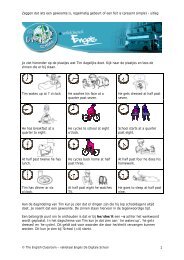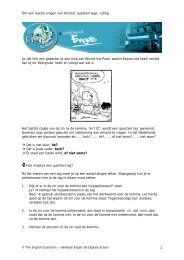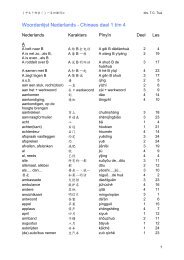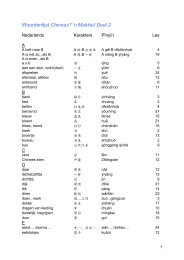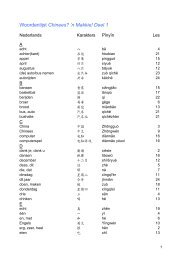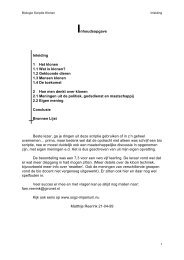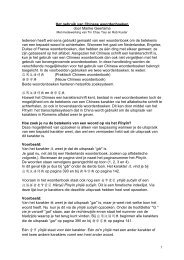Engels (nieuwe s tijl en oude stijl) Examen HAVO - Examenblad.nl
Engels (nieuwe s tijl en oude stijl) Examen HAVO - Examenblad.nl
Engels (nieuwe s tijl en oude stijl) Examen HAVO - Examenblad.nl
Create successful ePaper yourself
Turn your PDF publications into a flip-book with our unique Google optimized e-Paper software.
Tekst 3<br />
Eighte<strong>en</strong> smiles – but o<strong>nl</strong>y one is g<strong>en</strong>uine<br />
Most social animals use smell to signal to each other, but we rely on a<br />
sophisticated 50sq inches of skin and bone, writes Jerome Burne<br />
1<br />
2<br />
3<br />
4<br />
5<br />
10<br />
15<br />
20<br />
25<br />
30<br />
35<br />
40<br />
The peacock has its tail,<br />
the thrush its song and humans<br />
have the face.<br />
Fifty square inches of<br />
skin and bone create one<br />
of the most sophisticated<br />
signalling devices in the<br />
animal kingdom. While<br />
most social animals use<br />
smell to s<strong>en</strong>d messages<br />
about mating, fighting or<br />
social status, we rely on<br />
the face. This fine network<br />
of muscles that<br />
shape our huge range of<br />
expressions is so d<strong>en</strong>se<br />
and interconnected that<br />
anatomists cannot trace<br />
all the connections on the<br />
dissecting table. The o<strong>nl</strong>y<br />
wayisonalivingface.<br />
As social animals, our<br />
survival dep<strong>en</strong>ds on being<br />
able accurately to read the<br />
faces of others – are they<br />
hostile or fri<strong>en</strong>dly? – so<br />
we are programmed to<br />
respond to them from<br />
birth. The constant visual<br />
dialogue betwe<strong>en</strong> par<strong>en</strong>ts<br />
and child as they mirror<br />
expressions back and forth<br />
is vital for the developing<br />
brain. What’s more, babies<br />
as young as two months<br />
prefer attractive faces.<br />
Since the time of the<br />
Anci<strong>en</strong>t Greeks beauty<br />
has be<strong>en</strong> defined in mathematical<br />
terms – equal<br />
thirds vertically and equal<br />
6<br />
5 45<br />
50<br />
55<br />
60<br />
65<br />
70<br />
7<br />
75<br />
80<br />
85<br />
90<br />
95<br />
100<br />
8<br />
105<br />
110<br />
fifths from left to right –<br />
but now we use the language<br />
of evolution.<br />
Until puberty boys’ and<br />
girls’ faces have similar<br />
shapes, but under the<br />
sculpting effects of hormones,<br />
they diverge. Oestrog<strong>en</strong>,<br />
typically, gives<br />
wom<strong>en</strong> fuller lips and<br />
smaller chins, while<br />
testosterone l<strong>en</strong>gth<strong>en</strong>s the<br />
jaw. Young female faces<br />
are attractive because<br />
they say “I’m fertile”. But<br />
the hormonal shaping has<br />
to be symmetrical – not<br />
because it corresponds to<br />
some anci<strong>en</strong>t Greek ideal,<br />
but because symmetry in<br />
many species signals<br />
health. So females find<br />
symmetrical males more<br />
attractive.<br />
But faces ar<strong>en</strong>’t just<br />
features and proportions,<br />
their real signalling power<br />
comes from expressions<br />
forged in an evolutionary<br />
arms race to develop better<br />
techniques for deceiving<br />
and spotting<br />
cheaters. Persuading<br />
others you are sincere<br />
wh<strong>en</strong> you are lying, for<br />
instance, gives you an<br />
advantage but so does the<br />
ability to tell who is<br />
reliable.<br />
This trade-off is reflected<br />
in the smile. Babies<br />
recognise and respond to<br />
smiles at six weeks and<br />
we go on responding to<br />
them until we die. There<br />
are 18 differ<strong>en</strong>t sorts of<br />
smile but o<strong>nl</strong>y one is<br />
g<strong>en</strong>uine. Called the<br />
Duch<strong>en</strong>ne smile, it needs<br />
two sets of muscles – one<br />
around the mouth called<br />
the zygomatic and another<br />
around the eyes called the<br />
orbicularis. What makes it<br />
special is that, while you<br />
can consciously control<br />
the mouth muscles, the<br />
orbicularis o<strong>nl</strong>y responds<br />
to g<strong>en</strong>uine emotion.<br />
Good cheat detectors<br />
also watch the left side of<br />
the face. A g<strong>en</strong>uine emotion<br />
affects both sides of<br />
the face equally, but wh<strong>en</strong><br />
the feelings are phoney<br />
there t<strong>en</strong>ds to be more<br />
activity on the left. A<br />
lopsided grin in response<br />
to socks again at Christmas<br />
means they probably<br />
wer<strong>en</strong>’t very welcome.<br />
‘The Financial Times’<br />
300011 6A 4 Lees verder



